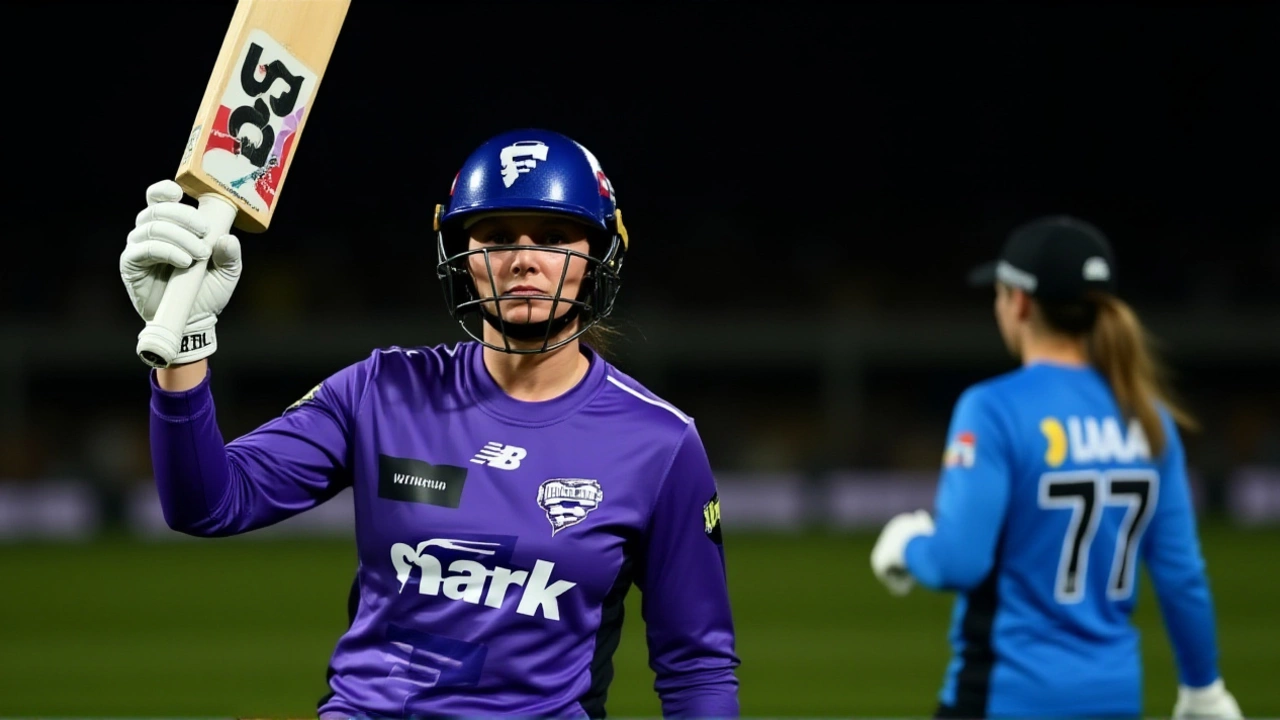When Sydney Thunder Women took the field against Perth Scorchers Women on November 19, 2025, they weren’t just chasing a win—they were chasing relevance. After three straight losses to start WBBL|11, their season was on life support. What followed wasn’t just a victory—it was a statement. Thunder crushed the defending champions by 90 runs at an undisclosed venue, posting 154 for 1 in just 18.2 overs before bowling out the Scorchers for a dismal 64. The win wasn’t pretty—it was brutal. And it changed everything.
Powerhouse batting dismantles Scorchers
It started quietly. Georgia Rachel Voll, opening the innings, looked composed, scoring 43 off 31 balls with seven boundaries. But the real fireworks came after her dismissal at 68/1. Enter Tahlia Beth Wilson and Phoebe Litchfield. Two of the most explosive batters in the league, they didn’t just accelerate—they detonated. Wilson, unbeaten on 55 off 44 balls, anchored with clinical precision. Litchfield, just 22 years old, responded with a blistering 50 off 35 balls—six fours and a six—that sent the Scorchers’ bowlers into disarray. Their 100-run partnership came in just 42 balls. At the drinks break, they were 80/1. By the end, they’d turned a modest target into a massacre.The powerplay yielded 26 runs with no losses. The final two overs—when field restrictions lifted—produced 22 more. No wickets. No panic. Just relentless, controlled aggression. It was the kind of innings that makes opposition captains question their plans—and their players’ confidence.
Scorchers’ batting collapse defies logic
Perth, the two-time defending champions, came into the match as favorites. But their reply was a masterclass in how not to chase. Katie Mack, their star, fought hard with 79 off 57 balls—nine fours, a classic performance. But she was alone. The rest of the lineup imploded. Beth Mooney, the anchor, managed just 17 off 25. Freya Kemp, expected to accelerate, was out for 11 off six. The Scorchers reached 50 in 7.1 overs, but then lost five wickets for just 14 runs. They never recovered. Their innings ended in 18.2 overs—same as Thunder’s. Only 64 runs. The lowest total in WBBL|11 so far.Thunder’s bowlers didn’t need to be spectacular. They just needed to be smart. Samantha Bates led the charge with 1/18 in four overs, consistently hitting the corridor of uncertainty. Taneale Peschel, Chamari Athapattu, Shabnim Ismail, and Lucy Finn each chipped in with a wicket. The pressure was constant. The field placements, tight. And the Scorchers—once so dominant—looked rattled from ball one.
Why this win matters more than the score
This wasn’t just about points. It was about belief. Sydney Thunder had lost their first three matches. They were seventh on the table. No one expected them to challenge the top four. But beating the Scorchers—by 90 runs, no less—sent shockwaves through the league. Suddenly, Thunder aren’t just a team trying to survive. They’re a team with momentum.“They didn’t just win,” said a veteran WBBL analyst on Cricket Times. “They showed they can outplay the best. That’s the difference between a team that’s lucky and one that’s dangerous.”
For Wilson and Litchfield, this was more than a personal milestone. It was proof that their partnership can carry a team. Wilson, a seasoned all-rounder, has been quietly brilliant all season. Litchfield, the young prodigy, has been hailed as Australia’s next big thing. Together, they’re becoming the spine of this Thunder side.

What’s next for Thunder and Scorchers?
Thunder now sit at 1-3. They’re still seventh, but they’re no longer winless. Their next match against the Adelaide Strikers could be the launchpad for a top-four push. The Scorchers, on the other hand, are reeling. Their defense of the title is in jeopardy. After three straight wins to start the season, they’ve now lost two in a row. Their batting depth is exposed. Their bowling attack, once fearsome, looks inconsistent.The league is tightening. Every game matters now. And for the first time since October, Thunder fans have something to believe in.
Behind the numbers: The turning points
- First wicket partnership: 50 runs in 33 balls (Voll 37, Wilson 10)
- Second wicket partnership: 50 runs in 42 balls (Wilson 23, Litchfield 25)
- Scorchers’ collapse: 50/0 to 64/7 in 11.1 overs
- Powerplay run rate: 6.5 runs per over for Thunder; 7.1 for Scorchers (but with wickets falling)
- Strike rates: Litchfield 142.86, Wilson 125.00, Mack 138.60
What stood out wasn’t just the numbers—it was the timing. Thunder never slowed. Scorchers never found rhythm. One team played like champions. The other looked like they’d forgotten how to play.
Frequently Asked Questions
How did Tahlia Wilson and Phoebe Litchfield’s partnership change the game?
Wilson and Litchfield’s 100-run stand in just 42 balls shifted the match’s momentum completely. After Georgia Voll’s dismissal at 68/1, the Scorchers had hope. But Wilson’s calm authority and Litchfield’s explosive finishing turned the innings into a demolition. Their partnership was the fastest 50-run stand between second-wicket pairings in WBBL|11, and it demoralized Perth’s bowlers before they could recover.
Why did Perth Scorchers collapse so badly after a strong start?
Perth’s top order, led by Katie Mack, built a foundation, but the middle order—especially Mooney and Kemp—failed to adapt to Thunder’s disciplined line and length. Samantha Bates and Peschel exploited the middle overs with tight lines, and the Scorchers couldn’t rotate strike. With no clear plan and pressure mounting, wickets tumbled in clusters. Their 50/0 became 64/7 in under 12 overs—a collapse rarely seen from a team of their caliber.
What does this result mean for Sydney Thunder’s playoff chances?
Thunder are still seventh, but they’re no longer winless. With four teams separated by just one or two points in the lower half, this win gives them breathing room. Their next three games—against Adelaide, Brisbane, and Melbourne Stars—are winnable. If Wilson and Litchfield continue this form, they could climb into the top four. Momentum matters more than rankings at this stage.
Is this a sign that Perth Scorchers are vulnerable this season?
Absolutely. Their batting depth has been exposed. Only Mack and Mooney consistently score. Their spin options are underused, and their death bowling lacks variety. Losing by 90 runs to a team they’ve beaten in past finals is a red flag. If they don’t fix their middle-order frailties in the next two weeks, their title defense could unravel.
How does this compare to past Thunder-Scorchers clashes in WBBL?
Historically, Perth has dominated Thunder, especially in finals. In WBBL|08, they won by 18 runs in the final. In WBBL|09, they won by 11 runs in the semi-final. This 90-run thrashing is the largest margin of victory Thunder has ever recorded against the Scorchers. It’s not just a win—it’s a psychological turning point in the rivalry.
What role did the pitch play in the outcome?
Though the venue wasn’t disclosed, reports suggest it was a flat, true surface with minimal assistance for bowlers. That made the Scorchers’ collapse even more surprising. If the pitch favored batting, Thunder’s innings should’ve been higher—and Perth’s should’ve been competitive. The fact that they were bowled out for 64 suggests mental fragility, not pitch conditions. This was a mental collapse, not a physical one.
